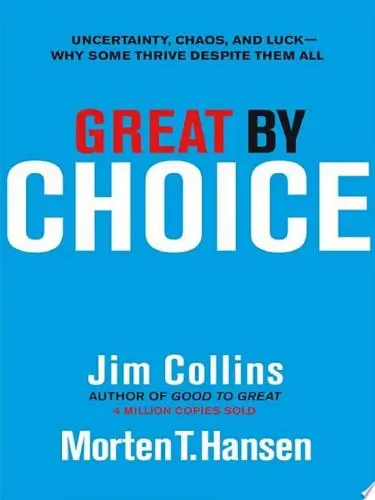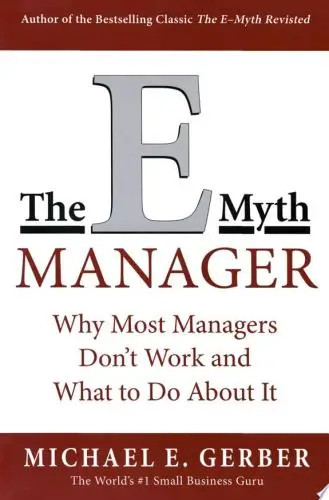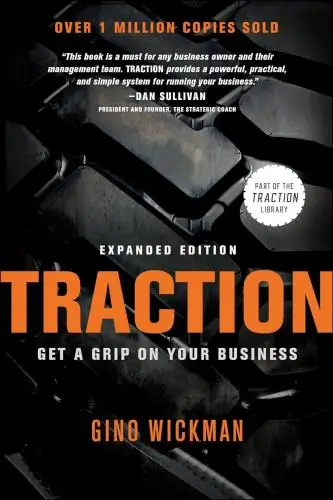Traction
Get a Grip on Your Business
What's it about?
Traction is a guide for entrepreneurs aiming to transform their businesses through disciplined planning and execution. Wickman introduces the Entrepreneurial Operating System (EOS), a practical method for achieving business success by mastering six key components: Vision, People, Data, Issues, Process, and Traction. This book is perfect for business leaders seeking to drive growth, improve team cohesion, and streamline operations for peak performance. Get ready to transform your business from the ground up and propel it to new heights with Traction.
About the Author
Gino Wickman is an author and entrepreneur best known for his book "Traction," where he introduces the Entrepreneurial Operating System (EOS), a practical method for business growth and management. His writing focuses on actionable strategies for organizational development, leadership, and team efficiency, offering a systematic approach to business success.
10 Key Ideas of Traction
Visionary Integration: Crafting a Clear Organizational Vision
A clear organizational vision aligns team efforts and sets a definitive direction for growth.
It involves defining long-term goals, core values, and a vivid description of what success looks like.
This clarity ensures that every team member understands their role in achieving the collective objectives, fostering a unified approach to decision-making and problem-solving.
By regularly revisiting and communicating this vision, organizations can adapt to changes while maintaining focus on their ultimate goals.
Learn DeeperDefine Your Core Values: Start by identifying what truly matters to your organization. These core values will serve as the foundation for your vision and decision-making processes. Gather input from team members to ensure these values resonate across the board.
Craft a Vivid Vision Statement: Imagine your organization's future success in detail. What does it look like? How does it feel? Write a vision statement that captures this future vividly, making it inspiring and clear to all team members.
Set Long-Term Goals: Break down your vision into achievable long-term goals. These should be specific, measurable, attainable, relevant, and time-bound (SMART). Each goal should align with your vision and core values.
Communicate Regularly: Share the vision, core values, and long-term goals with your team frequently. Use meetings, newsletters, or any communication tool at your disposal to keep everyone aligned and motivated.
Review and Adapt: The business landscape is always changing. Make it a habit to regularly review your vision and goals, adjusting them as necessary to stay on course towards your ultimate objectives.
- Example
A tech startup defines its core value as 'innovation for ease of life.' They craft a vision of becoming the leading provider of user-friendly tech solutions. Their long-term goal includes launching a groundbreaking product within the next five years. Regular team meetings focus on progress towards this vision, adapting strategies as market trends evolve.
- Example
A non-profit organization focused on environmental conservation sets 'sustainability' as its core value. Their vision involves creating a global network of conservation projects. They set long-term goals for project expansion and funding. Communication efforts include monthly newsletters and social media updates to keep supporters engaged and informed.
Data-Driven Decision Making: Utilizing Key Metrics for Growth
Implementing a data-driven approach involves identifying key performance indicators (KPIs) that accurately reflect the company's health and progress towards its goals.
Regularly monitoring these metrics enables leaders to make informed decisions, identify areas needing improvement, and recognize opportunities for growth.
This objective analysis minimizes biases and assumptions, leading to more strategic and effective management practices.
Learn DeeperIdentify Your KPIs: Start by determining which metrics are most crucial for your business. These could range from customer acquisition cost, profit margins, to employee satisfaction rates. Ensure these KPIs align with your long-term goals and can be accurately measured.
Set Up a Tracking System: Utilize tools or software that can help you track these KPIs regularly. This could be as simple as a spreadsheet for smaller businesses or more sophisticated analytics platforms for larger operations. The key is consistency in monitoring.
Regular Review Meetings: Schedule weekly or monthly meetings dedicated solely to reviewing these metrics. Use this time to assess performance, discuss strategies, and make decisions based on the data. Encourage open dialogue and brainstorming for solutions to underperforming areas.
Adjust Strategies Based on Data: Be prepared to pivot or adjust your strategies based on what the data is telling you. If certain initiatives aren't delivering the expected results, don't hesitate to reallocate resources or try new approaches. Flexibility is crucial in responding to real-time insights.
Educate Your Team: Ensure everyone in your organization understands the importance of these KPIs and how they contribute to the overall success. Training sessions or workshops can be beneficial in fostering a data-driven culture.
- Example
A small e-commerce business identifies its average order value (AOV) and customer lifetime value (CLV) as key metrics. They track these numbers monthly through their e-commerce platform's analytics tool, noticing a downward trend. In response, they launch a targeted email marketing campaign offering discounts to repeat customers, successfully increasing both AOV and CLV over the next quarter.
- Example
A tech startup focuses on user engagement as a primary KPI, tracking daily active users (DAU) and session length within their app. After observing a plateau in DAU, the team experiments with introducing new features based on user feedback. They closely monitor the impact of these changes on their KPIs, leading to a significant uptick in both user engagement and session lengths.
The People Component: Building a Cohesive and Capable Team
Success hinges on having the right people in the right seats.
This means recruiting individuals who not only have the necessary skills and experience but also fit the company culture and share its core values.
A cohesive team enhances productivity, fosters innovation, and maintains a positive work environment.
Regular evaluations and feedback ensure that team members grow with the company, contributing to its long-term success.
Learn DeeperDefine Your Core Values: Start by clearly defining the core values of your company. These should reflect what is truly important to the organization and guide how team members behave and make decisions.
Implement a Rigorous Hiring Process: Incorporate your core values into the hiring process. Ask questions that help you understand if a candidate not only has the skills but also fits well with the company culture.
Regular Performance and Fit Assessments: Schedule regular check-ins with team members to assess their performance and ensure they still align with the company's core values. Use this as an opportunity to provide constructive feedback and discuss growth opportunities.
Foster a Culture of Open Communication: Encourage team members to share their ideas, challenges, and feedback openly. This promotes innovation, helps identify issues early, and strengthens the team's cohesion.
Invest in Team Development: Provide opportunities for your team to grow their skills and advance in their careers. This could be through training, workshops, or mentorship programs.
- Example
During the hiring process for a new marketing manager, a tech startup focuses on candidates who not only have a strong marketing background but also demonstrate a passion for continuous learning and collaboration, aligning with the company's core values of innovation and teamwork.
- Example
A small business owner conducts quarterly performance reviews with her team, using the opportunity to discuss not just achievements and areas for improvement, but also how well each employee embodies the company's core values of integrity, customer focus, and respect.
Issues Solving Track: Systematic Problem Resolution
Adopting a structured process for identifying, discussing, and solving problems ensures that issues are addressed efficiently and effectively.
This involves creating an open environment where team members feel comfortable voicing concerns, followed by a systematic approach to brainstorming solutions and implementing action plans.
By tackling problems head-on, companies can prevent minor issues from becoming major obstacles, ensuring steady progress towards their goals.
Learn DeeperCreate a 'Safe Space' for Discussion: Encourage an environment where team members feel comfortable sharing their concerns without fear of judgment. This can be achieved by setting clear ground rules for respectful communication and actively listening to each other's viewpoints.
Implement Regular Problem-Solving Meetings: Schedule regular meetings dedicated solely to identifying and discussing issues within the team or project. This ensures that problems are addressed in a timely manner and don't escalate.
Use a Structured Problem-Solving Framework: Adopt a framework like the '5 Whys' technique to drill down to the root cause of a problem, or the 'IDEAL' model (Identify, Define, Explore, Action, Look back) for a comprehensive approach to solving issues.
Prioritize Issues: Not all problems are created equal. Use a method like the Eisenhower Matrix to prioritize issues based on their urgency and importance, ensuring that critical problems are addressed first.
Assign Clear Action Items and Deadlines: Once a solution is agreed upon, assign specific tasks to team members with clear deadlines. This accountability ensures that action plans are executed, and progress is made towards resolving the issue.
- Example
A software development team holds a bi-weekly 'bug bash' meeting where they prioritize and tackle the most critical bugs reported by users. They use a shared dashboard to track progress and ensure accountability.
- Example
A small business owner conducts monthly 'open floor' sessions where employees can voice any concerns or suggest improvements. They use a simple 'Start, Stop, Continue' format to structure the conversation and develop actionable plans.
Process Documentation and Optimization: Streamlining Operations for Efficiency
Documenting core processes and continuously seeking ways to optimize them is crucial for operational efficiency.
This includes standardizing procedures, eliminating redundancies, and automating tasks where possible.
A focus on process optimization leads to consistent product or service delivery, reduced costs, and the ability to scale operations effectively.
Engaging team members in this process encourages innovation and ownership over outcomes.
Learn DeeperIdentify Core Processes: Start by mapping out the key processes that are fundamental to your business operations. This could be anything from how you handle customer inquiries to how you manage inventory.
Document Each Step: For each core process, document every step in detail. This includes who is responsible for what and the expected outcomes. Use flowcharts or diagrams for visual clarity.
Seek Improvement Opportunities: Regularly review your processes to identify bottlenecks or unnecessary steps. Ask your team for feedback on how these processes can be made more efficient.
Implement Automation Tools: Look into software or tools that can automate repetitive tasks within your processes. This could range from email autoresponders to inventory management systems.
Standardize and Train: Once you've optimized a process, standardize it across your organization. Provide training for your team to ensure everyone is on the same page and can execute the process consistently.
Monitor and Adjust: Continuously monitor the performance of your processes. Be open to making adjustments as needed to further enhance efficiency or to adapt to new business needs.
- Example
A retail company documents its inventory management process, identifying that manual entry of stock levels is time-consuming and prone to errors. They implement an inventory management system that automatically updates stock levels based on sales, significantly reducing errors and saving time.
- Example
A marketing agency maps out its client onboarding process and realizes there are several redundant steps that delay project initiation. By eliminating these steps and introducing a client portal for direct information submission, they shorten the onboarding time and improve client satisfaction.
Deeper knowledge. Personal growth. Unlocked.
Unlock this book's key ideas and 15M+ more. Learn with quick, impactful summaries.
Read Full SummarySign up and read for free!
Traction Summary: Common Questions
Experience Personalized Book Summaries, Today!
Discover a new way to gain knowledge, and save time.
Sign up for our 7-day trial now.
No Credit Card Needed

Similar Books

Emotional Intelligence at Work
Dalip Singh
Seeing the Big Picture
Kevin Cope
Leadership Is Concept Heavy
Dr. Enoch Antwi
Great by Choice
Jim Collins
The Leader′s Guide to Coaching in Schools
John Campbell
Preparing School Leaders for the 21st Century
Stephan Gerhard Huber
The E-Myth Manager
Michael E. Gerber
Leadership Is Language
L. David Marquet
Start-up Nation
Dan Senor
The Founder's Dilemmas
Noam WassermanTrending Summaries

Peak
Anders Ericsson
Never Split the Difference
Chris Voss
Smart Brevity
Jim VandeHei
The Psychology of Money
Morgan Housel
The First 90 Days
Michael D. Watkins
Atomic Habits
James Clear
Thinking, Fast and Slow
Daniel Kahneman
The Body Keeps the Score
Bessel van der Kolk M.D.
The Power of Regret
Daniel H. Pink
The Compound Effect
Darren HardyNew Books

The ^AOxford Handbook of Job Loss and Job Search
Ute-Christine Klehe PhD
Job Interviews For Dummies®
Joyce Lain Kennedy
Job Interviews In A Week
Alison Straw
Handbook of Career Development
Gideon Arulmani
The Art of Spending Money
Morgan Housel
$100M Offers
Alex Hormozi
A Candle for Kiri
Edna Mae Holm
Principles of Marketing, Global Edition
Gary Armstrong
Serpent Rising: The Kundalini Compendium
Neven Paar

